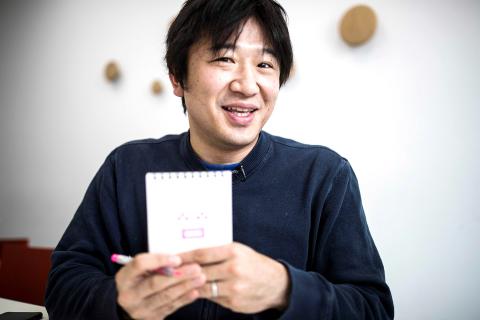From a humble smiley face with a box mouth and inverted “V”s for eyes, crude weather symbols, and a rudimentary heart — emoji have exploded into the world’s fastest-growing language.
There are about 1,800 emoji characters — and counting. They cover everything from emotions and food to professions, are racially diverse and have become an integral part of the smartphone age.
The digital hieroglyphics are regarded as so significant that New York’s Museum of Modern Art (MoMA), which is home to works by Andy Warhol and Pablo Picasso, is exhibiting the original 176 designs.

Photo: AFP
Shigetaka Kurita, the man who created the characters, is still surprised by the success of his idea, but says he was meeting an obvious need.
“It wasn’t only Japanese who felt inconvenienced when they were exchanging text messages. We were all feeling the same thing,” he says.
Kurita was working at major telecom NTT DoCoMo in 1999 when he sketched out one of the first emoji, a clunky-looking thing barely recognizable as the precursor to today’s yellow smiley face.
Kurita was also experimenting with how to make information, such as weather forecasts, more accessible on the small screens of emerging cellphones, deciding visual aids would help. The sun and umbrella symbols — both open and closed — were among his earliest creations.
For inspiration, Kurita says he tapped Japan’s popular manga comics and the country’s complicated writing system that uses two sets of phonetic letters mixed with Chinese characters, known as kanji.
Keenly aware of how text messages could be misconstrued, he wanted to create visual accompaniments to help articulate tone.
“With a heart, the message can’t be negative whatever the text says,” Kurita says, describing his motivation to include the sign.
This month Kurita is going to New York to visit the exhibition honoring his creation, whose name is a combination of the Japanese words for pictures and letters.
“These 12 x 12 pixel humble masterpieces of design planted the seeds for the explosive growth of a new visual language,” Paul Galloway, a design collection specialist at the museum, wrote on its Web site.
Among Kurita’s ideas for original emoji was a pile of feces.
“I made poo. It’s childish, but I thought it’s good to have something that makes people chuckle,” he said. “The company turned it down for the sake of its corporate image.”
Today, a smiley-faced poop is one of the world’s most popular emoji, though according to the emojitracker Web site, a face with tears of joy is the symbol that is used the most.
Despite being popular in Japan around the turn of the century, it took another decade for emoji to really take off globally.
Their success is in part due to the soaring popularity of smartphones, which has resulted in a jump in mobile messaging.
Around 2010, a consortium of tech firms adopted a standardized table so that emoji could be used across different platforms. Subsequently they became available on the iPhone and there was no turning back.
They are now found in every type of online communication, whether it is tennis star Roger Federer using them to announce his comeback from an injury or Australian Foreign Minister Julie Bishop sending an angry red face to describe Russian President Vladimir Putin.
Reality star Kim Kardashian, who has 88.9 million followers on Instagram alone, developed her own range of “Kimoji” symbols. There are also apps for users to create their own, personalized emoji and avatars.
It is estimated emojis are used by 92 percent of the “online population,” according to the 2015 Emoji Report, released by a digital marketing firm.
In the same period, the Oxford Dictionary chose an emoji as its word of the year.
This month, a London translation agency said it was advertising for its first “emoji translator” to help meet the “challenges posed by the world’s fastest-growing language.”
“We have turned a corner in writing, whereby phonetic script and visual symbols are being integrated more and more,” said University of Toronto anthropology professor Marcel Danesi, author of The Semiotics of Emoji: The Rise of Visual Language in the Age of the Internet.
“In some ways, [emoji] have rendered communication much more fluid and effective,” he said.

Archeologists in Peru on Thursday said they found the 5,000-year-old remains of a noblewoman at the sacred city of Caral, revealing the important role played by women in the oldest center of civilization in the Americas. “What has been discovered corresponds to a woman who apparently had elevated status, an elite woman,” archeologist David Palomino said. The mummy was found in Aspero, a sacred site within the city of Caral that was a garbage dump for more than 30 years until becoming an archeological site in the 1990s. Palomino said the carefully preserved remains, dating to 3,000BC, contained skin, part of the

TRUMP EFFECT: The win capped one of the most dramatic turnarounds in Canadian political history after the Conservatives had led the Liberals by more than 20 points Canadian Prime Minister Mark Carney yesterday pledged to win US President Donald Trump’s trade war after winning Canada’s election and leading his Liberal Party to another term in power. Following a campaign dominated by Trump’s tariffs and annexation threats, Carney promised to chart “a new path forward” in a world “fundamentally changed” by a US that is newly hostile to free trade. “We are over the shock of the American betrayal, but we should never forget the lessons,” said Carney, who led the central banks of Canada and the UK before entering politics earlier this year. “We will win this trade war and

‘BODIES EVERYWHERE’: The incident occurred at a Filipino festival celebrating an anti-colonial leader, with the driver described as a ‘lone suspect’ known to police Canadian police arrested a man on Saturday after a car plowed into a street party in the western Canadian city of Vancouver, killing a number of people. Authorities said the incident happened shortly after 8pm in Vancouver’s Sunset on Fraser neighborhood as members of the Filipino community gathered to celebrate Lapu Lapu Day. The festival, which commemorates a Filipino anti-colonial leader from the 16th century, falls this year on the weekend before Canada’s election. A 30-year-old local man was arrested at the scene, Vancouver police wrote on X. The driver was a “lone suspect” known to police, a police spokesperson told journalists at the

North Korean leader Kim Jong-un has unveiled a new naval destroyer, claiming it as a significant advancement toward his goal of expanding the operational range and preemptive strike capabilities of his nuclear-armed military, state media said yesterday. North Korea’s state-run Korean Central News Agency (KCNA) said Kim attended the launching ceremony for the 5,000-tonne warship on Friday at the western port of Nampo. Kim framed the arms buildup as a response to perceived threats from the US and its allies in Asia, who have been expanding joint military exercises amid rising tensions over the North’s nuclear program. He added that the acquisition